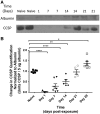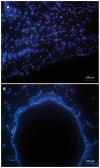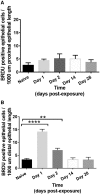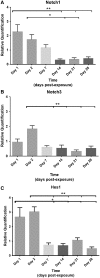From the Cover: ImpairedProliferation and Differentiation of the Conducting Airway Epithelium Associated With Bronchiolitis Obliterans After Sulfur Mustard Inhalation Injury in Rats
- PMID: 28402575
- PMCID: PMC6075598
- DOI: 10.1093/toxsci/kfx057
From the Cover: ImpairedProliferation and Differentiation of the Conducting Airway Epithelium Associated With Bronchiolitis Obliterans After Sulfur Mustard Inhalation Injury in Rats
Abstract
Sulfur mustard (SM) is a chemical warfare agent that causes chronic airway remodeling. This study's objective was to assess for changes to the bronchiolar epithelium after SM exposure to explain its contribution to chronic airway remodeling.
Materials and methods: Adult male rats were exposed to a sublethal dose of SM inhalation (1.0-1.2 mg/kg) for 50 min. Histological sections of the bronchiolar epithelium were analyzed for changes using hematoxylin and eosin, trichrome, and immunofluorescent staining for acetylated tubulin (AT) and club cell secretory protein (CCSP). CCSP in bronchoalveolar lavage fluid was assessed using western blot. A bromodeoxyuridine (BRDU) assay was used to assess for epithelial proliferation, and real-time PCR measured changes in Notch mRNA expression.
Results: SM caused significant proximal bronchiolar epithelial injury with epithelial denudation, loss of acetylated tubulin and CCSP staining, and reduced bronchoalveolar lavage fluid CCSP levels. bromodeoxyuridine (BRDU) + staining of proximal bronchiolar epithelial cells was not increased, but staining was increased in the distal bronchiolar epithelium. One month after injury, the proximal bronchiolar epithelium was not fully repaired. Significant collagen deposition surrounded proximal bronchioles with luminal obstruction, consistent with bronchiolitis obliterans. These changes corresponded with a downregulation of Notch1, Notch3, and Hes1 mRNA expressions.
Conclusions: This study demonstrates that SM exposure resulted in severe proximal airway epithelial injury, persistent morphological changes, impaired epithelial proliferation and, ultimately, bronchiolitis obliterans. These changes occurred at the same time that the Notch signaling genes were downregulated. Thus, the lung epithelium and the Notch signaling pathway may be worthy targets for the prevention of chronic airway remodeling after SM inhalation injury.
Keywords: Notch; bronchiolitis obliterans; epithelium; proliferation; regeneration; sulfur mustard.
Published by Oxford University Press on behalf of the Society of Toxicology 2017. This work is written by US Government employees and is in the public domain in the US.
Figures








Similar articles
-
Bronchiolitis Obliterans and Pulmonary Fibrosis after Sulfur Mustard Inhalation in Rats.Am J Respir Cell Mol Biol. 2018 Jun;58(6):696-705. doi: 10.1165/rcmb.2017-0168OC. Am J Respir Cell Mol Biol. 2018. PMID: 29314868 Free PMC article.
-
Mechanism underlying acute lung injury due to sulfur mustard exposure in rats.Toxicol Ind Health. 2016 Aug;32(8):1345-1357. doi: 10.1177/0748233714560603. Epub 2014 Dec 23. Toxicol Ind Health. 2016. PMID: 25537624
-
An international collaborative pathologic study of surgical lung biopsies from mustard gas-exposed patients.Respir Med. 2008 Jun;102(6):825-30. doi: 10.1016/j.rmed.2008.01.016. Epub 2008 Mar 12. Respir Med. 2008. PMID: 18339530
-
Clinical and paraclinical guidelines for management of sulfur mustard induced bronchiolitis obliterans; from bench to bedside.Inhal Toxicol. 2012 Nov;24(13):900-6. doi: 10.3109/08958378.2012.725783. Inhal Toxicol. 2012. PMID: 23121299 Review.
-
The role of N-acetylcysteine in the management of acute and chronic pulmonary complications of sulfur mustard: a literature review.Inhal Toxicol. 2014 Aug;26(9):507-23. doi: 10.3109/08958378.2014.920439. Inhal Toxicol. 2014. PMID: 25055840 Review.
Cited by
-
Assessment of Beta-2 Microglobulin Gene Edited Airway Epithelial Stem Cells as a treatment for Sulfur Mustard Inhalation.Front Genome Ed. 2022 Feb 7;4:781531. doi: 10.3389/fgeed.2022.781531. eCollection 2022. Front Genome Ed. 2022. PMID: 35199100 Free PMC article.
-
Single-cell resolution of human airway epithelial cells exposed to bronchiolitis obliterans-associated chemicals.Am J Physiol Lung Cell Mol Physiol. 2024 Feb 1;326(2):L135-L148. doi: 10.1152/ajplung.00304.2023. Epub 2023 Dec 12. Am J Physiol Lung Cell Mol Physiol. 2024. PMID: 38084407 Free PMC article.
-
Long-term Respiratory Effects of Mustard Vesicants.Toxicol Lett. 2020 Feb 1;319:168-174. doi: 10.1016/j.toxlet.2019.10.026. Epub 2019 Nov 4. Toxicol Lett. 2020. PMID: 31698045 Free PMC article. Review.
-
Reply to: Comment on "Bronchiolitis Obliterans and Pulmonary Fibrosis after Sulfur Mustard Inhalation in Rats".Am J Respir Cell Mol Biol. 2018 Aug;59(2):274-275. doi: 10.1165/rcmb.2018-0119LE. Am J Respir Cell Mol Biol. 2018. PMID: 30067093 Free PMC article. No abstract available.
-
Targeting Tumor Necrosis Factor Alpha to Mitigate Lung Injury Induced by Mustard Vesicants and Radiation.Disaster Med Public Health Prep. 2023 Oct 18;17:e553. doi: 10.1017/dmp.2023.178. Disaster Med Public Health Prep. 2023. PMID: 37848400 Free PMC article. Review.
References
-
- Allon N., Amir A., Manisterski E., Rabinovitz I., Dachir S., Kadar T. (2009). Inhalation exposure to sulfur mustard in the guinea pig model: Clinical, biochemical and histopathological characterization of respiratory injuries. Toxicol. Appl. Pharmacol. 241, 154–162. - PubMed
-
- Anderson DR, Byers SL, Vesely KR. 2000. Treatment of sulfur mustard (HD)-induced lung injury. J Appl Toxicol. 20 Suppl 1, S129–S132. - PubMed
-
- Beheshti J., Mark E. J., Akbaei H. M., Aslani J., Ghanei M. (2006). Mustard lung secrets: Long term clinicopathological study following mustard gas exposure. Pathol. Res. Pract. 202, 739–744. - PubMed
-
- Cabiati M., Raucci S., Caselli C., Guzzardi M. A., D’Amico A., Prescimone T., Del Ry S. (2012). Tissue-specific selection of stable reference genes for real-time PCR normalization in an obese rat model. J. Mol. Endocrinol. 48, 251–260. - PubMed
MeSH terms
Substances
Grants and funding
LinkOut - more resources
Full Text Sources
Other Literature Sources
Medical
Miscellaneous

